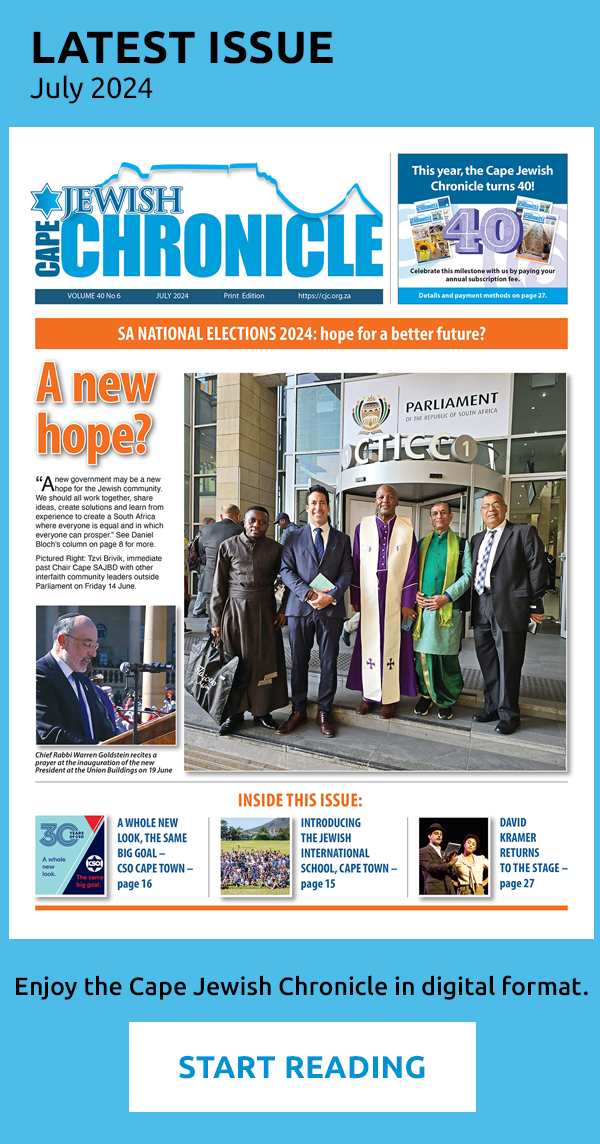As I write this I, along with the rest of the country and much of the world, am in lockdown.
While in many ways this is an unprecedented crisis, there are parallels in Jewish history that call out over time. Reading the famous Diary of Anne Frank or the less famous but just as inspirational teachings of the Piaseczno Rebbe, Reb Kalonymus Kalman Shapira, who tried to give his chassidim hope in the Warsaw Ghetto during the Nazi occupation and who was eventually murdered along with his students, gives a sense of the feeling of crushing pressure they experienced. For me, thank G-d, I have food in the fridge, my family around me and the internet to connect me to the world and you at this time. And the only Nazi seeking my death is a tiny microscopic virus aiming to wriggle through my soapy defences and hunt me down. I won’t let it.
But there are other parallels that go even further back in time — it struck me in preparing for Pesach that the Jews in Egypt experienced a lockdown too as they waited for redemption. As the Angel of Death made its destructive path through Egypt, the Israelites were instructed to daub blood on the doorposts and “you shall not leave the entrance of the house until morning.” (Ex 12:22) Can you imagine the fear and horror cooped inside with the sounds of massacre and mourning in their ears?
But it is actually the ninth plague that speaks to our current reality — the plague of darkness. As a sidebar, the last three plagues all involved darkness of some kind — the locusts (plague eight) covered the earth so that it could not be seen, eating up every scrap of potential nourishment, and the death of the firstborn (plague ten) was a physical and spiritual darkness unlike any other. In the face of these horrors, what could be so bad about the ninth plague, a bit of darkness? And what was the plague really? Surely no problem. Unlike each of the other plagues over which they had no control whatsoever, the Egyptians could have simply lit a candle or two to dispel the gloom?
But here the phrase that tellingly opens the tragedy to our minds is the one that says, lo ra’u ish et achiv – “but no man could see his brother” (Ex 10:23). It brought back the very reason that the Israelites were in Egypt in the first place — that the sons of Jacob never really ‘saw’ Joseph as their brother at all. And because of this, threw him in the pit, sold him into slavery and eventually joined him in Egypt in the famine.
Why didn’t the Egyptians light candles — it was a darkness greater than any other, “a darkness that could be touched” (Ex 10:21), so thick that not only could they not see, but they could not even move. What paralysed the Egyptians? Was it exhaustion or depression from the onslaught of the plagues? Seeing their country ripped apart and brought to its knees? Or even realising how much their economy and their lives depended on the abuse of these “foreign workers” who had lived in their midst for 400 years?
Here again, the fact that no man could see his brother replays in our ears. For surely there is no greater darkness than those who choose not to see? To recognise their fellow human? Perhaps the plague that struck the Egyptians was their inability to see their fellows’ suffering whether their slaves or their countrymen.
There is a discussion in the Talmud over what time one can say the Sh’ma in the morning. When is morning? Rabbi Meir says that you can say the morning Sh’ma from the time that one can distinguish between two similar animals, e.g. a wolf and a dog. Rabbi Akiva provides a different sign, and says that the day begins when there is sufficient light to distinguish between a donkey and a wild donkey. But then the other rabbis join the conversation and suggest a different measure. They say the time for the morning Sh’ma is when one can see another person from a distance of four cubits and recognise them. (B.Talmud, Brachot 9b)
Two striking things here — firstly that distance of four cubits is more or less two metres, the social distancing measure of today. Secondly that in Jewish legal discussion ‘dawn’ is defined as when one can recognise the face of someone you know.
In other words, the way to overcome darkness, to move from night to dawn, is to recognise the other, from across the social distance. And here lies the greatest Torah teaching for our lockdown. We have been given tools the Egyptians did not have, or if they did, chose not to use. We can reach out with all the technology that we have to make the walls of our confinement permeable. We can call or WhatsApp our beloved family and friends. We can Zoom in or join countless lectures, concerts and shiurim around the world, which has never felt more connected. We can go to shul virtually. And we can lean over the fence or balcony and say hi to our neighbours that we might never speak to in normal circumstances. And of course, we have that most ancient technology of all — prayer.
If we use these tools, we can keep the plague of darkness at the door, and even more than that, help to bring light to our lockdown pod and the world outside. May we read this in continued good health for us and all those who dwell on this Earth, and may we all have light and bring light in these times.
By Rabbi Greg Alexander
To read or download the full May issue PDF of the Chronicle, click here
To keep up to date on COVID-19 related community news, click here
Portal to the Jewish Community: to see a list of all the Jewish organisations in Cape Town with links to their websites, click here
To receive the Chronicle each month in your inbox instead of your postbox please email editor@ctjc.co.za and we will make it happen.
Follow the Chronicle: Facebook | Instagram | Twitter | LinkedIn










